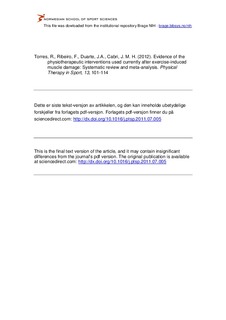| dc.description.abstract | Introduction:
Exhaustive and/or unaccustomed exercise, mainly involving eccentric muscle actions, induces temporary muscle damage, evidenced by delayed onset muscle soreness (DOMS) and decreased muscle function. Different strategies to recover from its signs and symptoms have been studied and, as a result, a significant number of articles on this issue have been published.
Objective:
To assess whether some modalities currently used in physiotherapy such as massage, cryotherapy, stretching and low-intensity exercise are effective for treating the signs and symptoms of exercise-induced muscle damage.
Methods:
Randomized controlled trials (RCTs), written in English or Portuguese, that included physiotherapeutic interventions [i.e., massage, cryotherapy, stretching and low-intensity exercise, on adult human subjects (18–60 years old) of both gender] were searched on electronic databases including MEDLINE, CINHAL, EMBASE, PEDro and SPORTDiscus.
Main outcome measures:
“Muscle soreness” and “muscle strength” were the outcome measures included in the meta-analysis.
Results:
Thirty-five studies were included; nine analysed the effects of massage, 10 examined the effects of cryotherapy, nine investigated the effects of stretching and seven focused on low-intensity exercise intervention.
Massage was the only intervention with positive effects, reducing soreness at 24 h, on average, 0.33 on 10 cm visual analog scale (95 percent CI: −0.59, −0.07) and increasing muscle recovery by 1.87 percent (95 percent CI: 0.30, 3.44). Additionally, there is inconclusive evidence to support the use of cryotherapy, while there is little evidence to prove the efficacy of stretching and low-intensity exercise.
Conclusion:
Massage proved slightly effective in the relief of symptoms and signs of exercise-induced muscle damage. Therefore, its mean effect was too small to be of clinical relevance. There is a lack of evidence to support the use of cryotherapy, stretching and low-intensity exercise.
Keywords:
Eccentric exercise; Delayed-onset muscle soreness; Physiotherapy; Effectiveness | no_NO |
